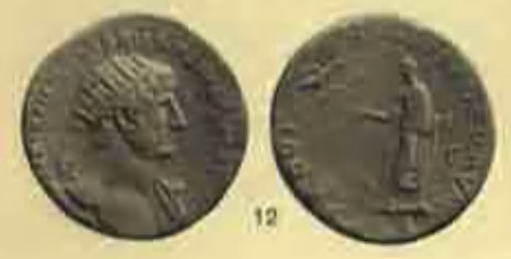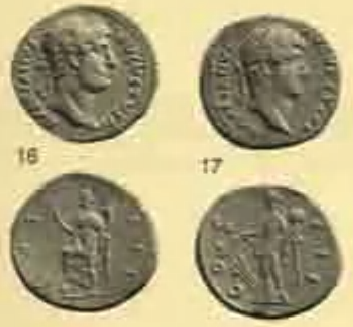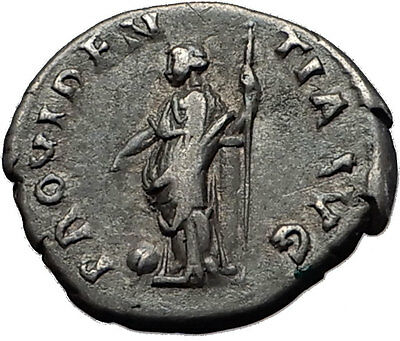
Even though I went through a “Hadrian focus” in my reading some years back, I remained unaware of the potential relevance of several details of that emperor’s reign to the Book of Revelation as highlighted by Thomas Witulski’s several works. So when my good friend Serendipity showed me another work independently addressing some of the same issues Witulski covered, I once again put blog posting on hold until I could finish reading that new work along with several of its citations. The “new” work is a PhD thesis by Demetrios Kritsotakis and the extracts below will tell you why I think it is an appropriate addition to the discussion of Witulski’s thesis:
Hadrian and the Divine
An important factor that determined Hadrian’s policy in the East was his personality. Among other things, the emperor was interested in divination and mystic cults, magic and superstitions, was skilled in astrology, knowledge of every science and art, and was even credited with healing powers. Although this aspect of his personality is not directly connected with his cult in the region, it pertains to the divine, the superhuman and as such I deem it worthy of being examined here. Moreover, I believe that these interests of his facilitated his reception among the. Greeks. They were part of the religion-colored language that the Greeks and the emperor used to communicate with each other.
In spite of the fact that this aspect of Hadrian’s life was the subject of great interest in our sources, modern scholarship has underestimated the significant role that it played in the creation of his image in the East.
(Kritsotakis, Demetrios. Hadrian and the Greek East: Imperial Policy and Communication. PhD, Ohio State University, 2008. pp. 186f.)
and . . .
This chapter will discuss the role of religion in the promotion of Hadrian’s program and vision for the Greek East in the region. The center of his religious program was the imperial cult, which focused on the emperor but also on the imperial house, especially his wife Sabina, and outside of it on his young lover Antinoos. However, here I will not talk about the mechanisms of the cult and the individuals involved. This has been amply treated in modern scholarship. Instead, I will discuss aspects of his religious program that have not received the attention they deserve so far. (K, p 161)
I will post in two parts a series of extracts from Kritsotakis’ thesis, grouping them under headings relevant to W’s interpretations of Hadrian in Revelation. (The one detail K does not mention is the introduction in Asia Minor of private household shrines for Hadrian.)
Emperor Cult Taken to New Levels
Hadrian received more divine honors in the Greek East than any of his predecessors. These honors, among them the unprecedented erection of statues, his worship in shrines, and close association with many Greek divinities, strengthened his relationship with the region and placed him in the heart of religion and the Greek pantheon. In honoring him the Greeks identified Hadrian with major divinities of their pantheon. Hadrian became the manifestation of Zeus, Apollo and other gods on earth, and a number of epithets were used to address him as a god. (K. 162)
.
Hadrian was hailed by the Greeks in an unprecedented association with Zeus and was viewed by them as the new Olympian who would preside over their councils and lead them. (163)
.
To start at the beginning, Hadrian promoted his appointment as emperor as the direct result of divine appointment. Among the senatorial ranks in Rome questions had been raised about the legitimacy of his succession to Trajan.

Thus, early in his reign, Hadrian wanted to state his divine election publicly. . . . [T]he message carried here [the eagle coming to Hadrian in the coin image above] was that it was not by the foresight of mortal men or even a mortal now deified, but by the foresight and the care which the gods exercised for the Roman commonwealth that Jupiter sent his messenger, the eagle, to grant Hadrian the ruling of the world. . . .
. . . if it were ever doubted whether Rome’s rulers were appointed by chance or by the gods, it is now clear that the present princeps owes his position to the will of the gods; not by dark processes of fate, but clearly and openly by Jupiter himself. (167-168)
But back to the worship of Hadrian . . .
Zeus manifest:
Indeed, from 128 onwards the commonest epithet of Hadrian was Olympios or the variation Hadrianos Zeus Olympios. In Sparta there was a civic cult of Zeus Olympios in Hadrian’s honor, and in Athens the emperor founded the Olympia games in honor of Zeus Olympios. In adopting the epithet Olympios, Hadrian was in fact emphasizing his Panhellenic program, for Zeus Olympios, chief deity of the Greeks, is the Panhellenic god. Hadrian becomes the new Zeus. The emperor is the reincarnation of that Zeus of the old myths and becomes the head of Olympos. At the same time by receiving the epithet Panhellenios he becomes the power that presides over the commonwealth of the Greek cities, he is the Zeus of all the Greeks. (210)
.
Hadrian Olympios
Hadrian’s hearty reception among the Greeks found its greatest numismatic expression in the depiction of the emperor as Olympios. The use of the epithet Olympios for Hadrian is attested for the first time in 128 but becomes regular after 131/2, the year in which the Olympieion was finished, the statue of Olympios Zeus was dedicated in it, and the Panhellenion was founded by Hadrian. By addressing the emperor as Olympios the cities clearly identified him with the head of the gods. Now Hadrian becomes not the god of a single Greek city but of the entire Greek world. . . . . Hadrian paid special attention to his reception as the earthly counterpart of Zeus. Certainly the coins. . . as well as numerous inscriptions that honored him as Olympios, reflect this atmosphere.
According to current numismatic evidence, nine cities named Hadrian Olympios on their coins: the Roman colony of Dion in Achaea, the city of Cos, and from Asia Minor, Cyzicus, Ephesos, Eumeneia, Hydrela, Kame, Sagalassos, and Tarsos. . . .
. . . The dative case (Hadriano Olympio) that occurs both on the coin and the inscription testifies to the fact that in both instances we have a dedication to Olympios Hadrian, a clear reference to the divine status of the emperor. This remarkable double dedication is an unprecedented honor for an emperor by the city of Dion. . . .
. . . more striking since no city in Achaea attributed the epithet Olympios to Hadrian on coinage, in contrast to the cities of Asia Minor where numerous coin issues carry the title. (133ff.)
.
Is there really any doubt that the ancient visitor to the temple at Pergamos, once he saw the colossal statue of Hadrian in the sekos, would infer that the emperor had a share now in the worship offered there? Moreover, in what concerns Trajan and Hadrian, we must underline the fact that Trajan was honored as Zeus after his death while Hadrian already during his life. In the only instance where Trajan was worshipped along with (and not as) Zeus at Pergamos Hadrian “intruded” and his cult statue entered the temple. Thus Hadrian in a sense diminished Trajan’s importance in the temple and shifted the focus of the Pergamenes on himself. (215)
.
Hadrian was hailed as Zeus more than any of his predecessors and his gifts were manifestations of his providence and honest interest in the welfare of the region. The locals helped him re-invent himself in the form of Zeus. His grants to small and large sanctuaries alike made him the head of the gods, the leader of the Pantheon. As such, Hadrian is constantly honored in the monuments of the period. (215)
.
The number of monuments, statues and temples, dedications and inscriptions that are associated with him, dull the memory not only of his predecessor but also of the emperors of the first century among the Greeks. Hadrian neos Zeus became the counterpart of Trajan Jupiter. (215)
.
By assimilating with Zeus and focusing on his cult the emperor once again rejected his predecessor’s policy of annexing-and-Romanizing and instead promoted the idea of coexistence of Greek and Roman traditions for the welfare of the Roman empire. In the words of Jean Beaujeu, Hadrian practiced a “philhellénisme à dominante jovienne et meme olympienne.” (215)
.
The 13th God of Greece
In his Antilogy about Julian to the sophist Libanius, the church historian Socrates of Constantinople scoffs at the tendency of the Greeks to immortalize the dead. One of the examples he brings forth is that of the city of Cyzicus. The people of Cyzicus, he writes, declared Hadrian the 13th god. Hadrian himself, he continues, consecrated Antinoos, his lover . . . The author, who lived and wrote in the 5th century, refers without any doubt to the benefactions of the emperor to the city but especially the temple that Hadrian allowed the people of Cyzicus to build for his cult, thus Cyzicus becoming his neokoros. . . .
What is . . . important here is that the emperor himself made such an impact upon the Greeks of the 2nd century and of the time of Socrates that such epithets were often associated with him. (169f.)
.
. . . Hadrian’s characterization as θεὸς [theos = god] was part of the religious language employed to address the Roman emperors and the Hellenistic kings before them. What is more interesting in Hadrian’s case is his presentation as the new manifestation of a deity. The best way for the Greeks to describe this quality was the use of the epithet νέος [neos] followed by the name of the divinity. (171)
.
With regard to Hadrian neos Zeus, the epithets are mostly related to the emperor’s actions and benefactions to a city or a province, which in the eyes of his subjects raised him to the status of a divinity. The epithet most often used in association with Zeus was of course Olympios. The epithet is attested in a vast number of inscriptions and coins not only from the Greek cities but also, and this emphasizes more Hadrian’s image as Zeus, the Roman colonies of the Greek East and even the city of Rome. The use of the epithet Olympios for Hadrian is attested for the first time in 128, but becomes regular after 131/2, the year in which the Olympieion was finished, the statue of Olympios Zeus was dedicated in it, and the Panhellenion was founded by Hadrian. The vast number of dedications and other inscriptions that address Hadrian as Olympios is unprecedented. No emperor, with the exception of the first princeps, has been so called, and the latter only on a small number of dedications . . . . (172f.)
.
Not only as Zeus:
Another divinity with whom Hadrian is often associated is Dionysos. On the front seat of the theater of Dionysus in Athens, Hadrian received the epithet Eleutheraios in an inscription that reads “(seat) of the priest of Hadrian Eleutheraios”. This is the only example of a Roman emperor receiving this epithet in association with Dionysus. (176)
.
Hadrian’s epiphany as neos Dionysos was witnessed throughout the Greek world. (177)
.
To a lesser degree, Hadrian is considered the new manifestation of or is associated with Apollo, Asclepios, and Helios. Hadrian’s association with Apollo is mostly evidenced in the use of the epithet Pythios. (178)
.
The inscription is a dedication to Hadrian soter Olympios. The right part of the stone is missing and the inscription has been restored. If the restoration is correct, then the wording that follows is remarkable and requires extensive comment here. The language shifts from the dative case of the dedication on the first line of the text to the nominative, which is unusual. The text indicates that the base supported a statue of the emperor. Now the emperor is called lord of all men, king of all the lands, most manifest new Asklepios. . . (180)
.
Hadrian is called despotes in three other inscriptions in addition to the text from Pergamos. . . . . It is noteworthy that starting with Hadrian the epithet despotes is frequently associated with Roman emperors. (183)
.
Perhaps there is no better way to conclude this section of Hadrian’s “neos theos” manifestations than with the most “manifest of all”, Hadrian as Neos Helios. (185)
.
. . . his Greek subjects viewed Hadrian as the manifestation of the divine in an unprecedented way and extent. (186)
.
And what might have prompted the Greek world to bestow such honours on Hadrian?
In A.D 125 . . . dedicated a thank-offering to the emperor Hadrian, whom they addressed as “savior, who healed and nourished his own Greece.” The emperor is praised for his contributions to the life of the region. As a savior (ῥυσαμένῳ) and parent (θρέψαντι) Hadrian came to the rescue of his Greece and provided it with anything that it needed to recover and advance. What provoked the expression of such gratitude in addressing the emperor as healer and parent of the Greeks? Without any doubt the answer is found in the unparalleled benefactions to the cities, manifested in his interest in their everyday life and their cultural and political progress; in unmatched building programs; in donations to cities, leagues and individuals alike; and finally in his passion for everything Greek and respect for the culture of the region and its people. (pp. 33f.)
Hadrian instituted a new organization of Greek cities throughout Greece and Asia Minor, the Panhellenion. K writes:
I will argue that Hadrian’s goal, by creating the Panhellenion, was not so much to unite the Greeks politically but rather to highlight their cultural traditions with special emphasis on his cult.
. . . . Hadrian formally inaugurated the league and the associated temple of Hadrian himself, the Panhellenion, in 131/132, the same year in which he dedicated the sanctuary of Olympian Zeus. (p. 41)
Among the most important activities of the league was the cult of the emperor, evidenced in Dio (69.16.2) and in the inscriptions that mention the priest of the god Hadrian Panhellenios. A monument from Aezanoi, honoring the citizen M. Ulpius Eurycles, reveals that the archon of the Panhellenion wore a crown adorned with busts of the emperors: his had two busts, of Hadrian and Pius. (p. 49)
Three cities of particular interest to readers of Revelation, Smyrna, Pergamon and Ephesus, however, were not part of the Panhellion. The reason for their exclusion, K. suggests, is that those cities “already enjoyed the benefits of hosting the imperial cult, not only of Hadrian, but of his predecessors as well” and they presumably felt they would lose some of their status by becoming part of a league with Athens and Sparta as its leading cities (p. 55).
Given the current state of the evidence, the cult of the emperor was the most important activity of the league. It is possible that Hadrian intended his worship as a unifying force for the Greeks, especially of the mainland, and built the league around it. The cities of Asia Minor were already deeply involved in the institution of the imperial cult and were enjoying its benefits and the largess of the emperor. (p. 58)
Not quite “worship”, but within the ballpark:
The advent [cf “parousia”] of the emperor caused unprecedented hope, and people, regardless of age, gender or class, rushed through the fields and crowded the roads to welcome the emperor. The passage of the imperial train was also viewed as a kind of spectacle and certainly the locals felt proud to witness it. We may assume that a similar atmosphere took place wherever Hadrian happened to visit. . . .
Cities all over the Greek world rushed to congratulate the new emperor, introduce themselves and win his favor. (pp. 74f, 78)
.
Large and small cities alike were struggling to attract Hadrian’s interest. Even the otherwise unknown κώμη of Kaparanaia in southern Samaria set up a dedication to the gods for the safety of Hadrian, “the father of patris, the savior and benefactor of the world and the village of Kaparanaia.” (p. 76)
.
Beyond the Greek world:
It is unclear whether Hadrian’s health had been (temporarily) improved by his stay in Egypt. An issue from the mint of Rome may provide some insight into Hadrian’s expectations. The type, in both silver and bronze, depicts Hadrian’s laureate bust on the obverse. On the reverse, Hadrian standing in military dress holds spear and parazonium. His left foot rests on a crocodile. The legend S(enatus) C(onsultum) completes the scene. According to Anthony Birley, it is possible that we have here a depiction of Hadrian as Horus and thus as “King of Egypt”, the vanquisher of evil forces. He further argues that “it has also been pointed out that it had long been standard practice in Egypt for ill or afflicted persons to identify themselves with Horus and the demons that were causing them pain with scorpions, crocodiles and serpents. The identification, accompanied by spells, guaranteed a cure for the patient who had taken on the god’s identity.” If this is the case here, then it is possible that Hadrian felt that his resort to divinations and magic finally paid off. (193)
.
Not quite a god, but the personification of the virtues:
Hadrian showed a deep interest in virtues and his addition to the series [of coins with this theme] is outstanding: all his innovations are virtues: Liberalitas, Indulgentia, Patientia, Pudicitia, Tranquillitas; or quasi-virtues, Hilaritas and Disciplina. What is most remarkable is the series [of coins] issued in 128, which is responsible for most of the new virtues. In this year appeared in parallel Clementia, Indulgentia, Iustitia, Liberalitas, Patientia and Tranquilitas. The impression is of a ruler possessed of endless virtues. (139)
Providentia, who points at the globe on the ground and holds a scepter. The image is accompanied by the legend Providentia Aug. The message is clear: the emperor has cast his eyes upon the world, which he rules, and has the necessary forethought to anticipate its needs. (140)
One more example:

The portrayal of the emperor as Fortuna, although without precise parallel, is obvious enough, since the fors of the empire was intimately bound up with that of the emperor; this is implicit in the many Fortuna Aug types struck at Rome. The transfer of Fortuna’s attributes to Hadrian results in the emperor appearing veiled; this is rare in the imperial coinage except when the emperor is shown sacrificing. Yet the type has been modified in other respects: a scepter is substituted for the more common cornucopiae, and Hadrian is seated on a sella rather than the throne normally occupied by Fortuna. The fortune of the emperor secures the well-being and the prosperity of the world. (141)
.
Did the everyday citizen understand the images on the coins?
The people who used the coins knew what the symbolism meant. They were aware that the personification on the reverse referred to the person depicted on the obverse, the emperor. The personification was therefore in the power of, or an aspect of the emperor on the other side. The image transferred the quality of the virtue to the emperor and identified the emperor as a “charismatic” one. As a result, by invoking virtues and imperial principles the emperor legitimized his position. What, in my opinion, is more important, however, is that this series was a constant reminder to the people that the emperor, however far he might be, cared for them, pitied them, could not be deceived, and always exerted, to quote the phrase of one of Hadrian’s soldiers, “a care that never tires, with which he watches unrestingly over the good of mankind (infatigabili cura, per quam adsidue pro humanis utilitatibus excubat).” (142)
Again,
It is hazardous to believe that the populations did not recognize the symbolism of these scenes. As Papageorgiadou-Bani argues, “even if the language was not understood, it was hard to miss the symbolism.” Especially among populations such as the Greek, which had a long tradition of symbolic representations on their coinage, the visual depiction of a given idea remained much the same, whether this was, for example, the emperor’s virtues, or the beneficence he displayed toward a particular city or province. The coded coin legends, in conjunction with easily understood images, would have been reasonably understandable even to the least educated. (158)
Continuing….
Kritsotakis, Demetrios. Hadrian and the Greek East: Imperial Policy and Communication. PhD, Ohio State University, 2008.
If you enjoyed this post, please consider donating to Vridar. Thanks!



Would it be possible to date 2 Thessalonians to the “Emperor Cult Taken to New Levels”?
• Carrier (10 December 2018). “Adventures at the Society of Biblical Literature Conference, Part 3: Closing Out”. Richard Carrier Blogs.
It has been done: https://vridar.org/2011/05/31/identifying-the-man-of-sin-in-2-thessalonians/